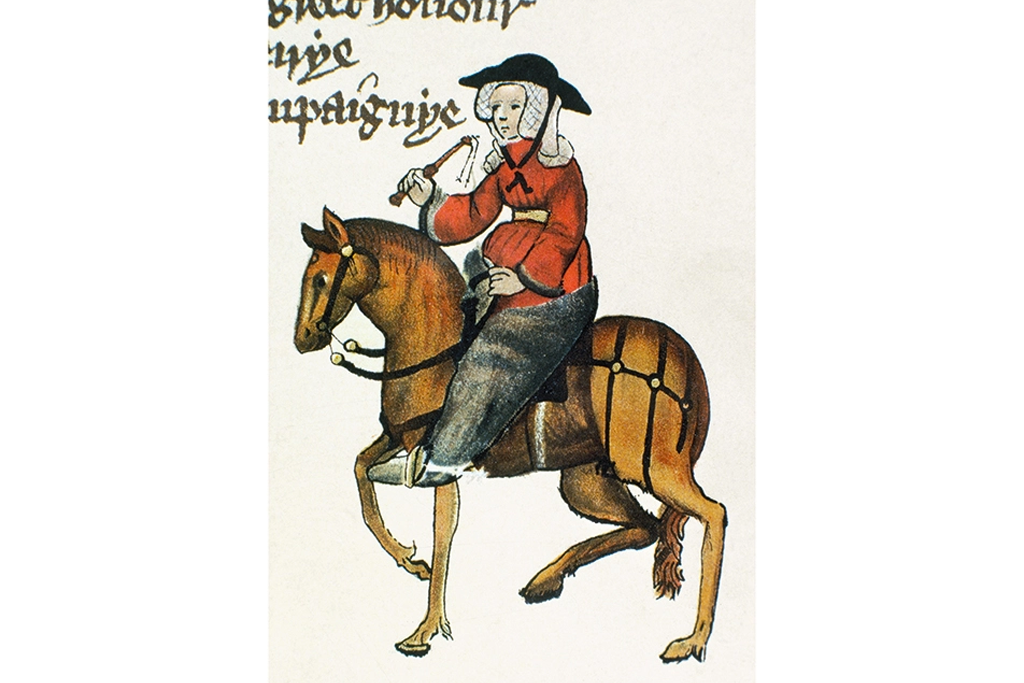Marion Turner has written a superb biography of a woman who never lived. Alison, the Wife of Bath in Chaucer’s Canterbury Tales, is one of the most famous of all medieval women, even though she has only ever existed on the page. But Turner’s beautifully written, rewarding and thought-provoking book about this imaginary woman shows how much her literary existence has to say about actual women’s lives.
The book is divided into two main sections. In the first, Turner examines four different aspects of Alison — the worker, married woman, storyteller and traveler — and expertly conceptualizes the late medieval English world and its attitudes to, and treatment of, women. In Alison, Chaucer gave the “ordinary middle-class woman in English literature” a voice for the first time. In the second section, Turner goes on to trace Alison’s many afterlives, from Shakespeare to Ted Hughes, and her reinventions in twenty-first-century Britain.
Chaucer wrote Alison in a way that encourages readers to love her — as a rounded character with an interior life. Opinionated, funny and often in a spot of trouble with her men, she was a type Chaucer knew well. A much-married (five times), independent, attractive, socially and sexually active middle-aged woman who worked hard and went on an occasional pilgrimage? There were lots of them around in the later fourteenth century. As a skilled craftswoman in a post-Black Death world of female wage labor and increased economic opportunities, Alison embodies the autonomous women of the time. Through her voice we can hear them, and how she uses her power is illuminating.
She speaks out against the prevailing misogyny. In a chapter entitled “The Female Storyteller,” Turner uses Alison’s famous question “Who peyntede the leoun, tel me who?” to illustrate the awareness many medieval women had of the inferior status imposed on them. The question is a reference to Aesop’s fable of a man and a lion, who, out for a walk, see a painting of a man choking a lion to death. The man regards it as proof of his superiority. The lion disagrees, and suggests that if a lion rather than a man had painted it the result would have been very different.
So it was with men and women, says Alison. Her encounters with misogyny (most notably in marriage number five, with the abusive clerk Jankyn) express how women perceived and objected to negative views of them. Medieval responses to Alison were often concerned with curbing her “rhetorical power”; but it does all seem to get nastier over subsequent centuries, as Alison refused to shut up.
Twentieth-century works about her ridicule her body and sexual appetites. How dare this opinionated older woman want sex, they seem to ask. Turner gives many surprising examples of this drift towards revulsion. Percy MacKaye’s early twentieth-century play The Wife of Bath had to be quickly rewritten owing to funders’ and actors’ disquiet about a piece in which a woman dominated. It became The Canterbury Pilgrims, and Alison’s role was much reduced and coarsened.
Later, in 1972, Pier Paolo Pasolini (a man not averse to a bit of misogyny himself) included an Alison in his film version of the Canterbury Tales whose abhorrent behavior confirmed that “sexual activity with an older, experienced woman is a form of death.” In such modern works we see men as victims of a prowling, voracious, grotesque woman, and Chaucer’s original focus on male dominance and aggression gets completely subverted.
The ebb and flow of misogyny over time is further explored in Eleanor Janega’s The Once and Future Sex. This is a survey of a broad subject — medieval European thinking about how women should live in the world — with a focus on their sexuality, beauty and general behavior. The author examines not only the ways in which men thought women should live but also how ordinary women did live in a world predicated on their inferiority.
Like Turner, Janega includes a modern perspective, arguing that the arc of women’s history is not necessarily one of linear progression, whatever we might like to think. In a world of incels, body-shaming and a gender pay gap, she contends, we cannot afford to congratulate ourselves smugly on progress if we don’t understand what has gone on before, and how that influences where we are now.
Both the subject matter and the author’s engaging conversational style make this a book of many delights. Hildegard of Bingen is described as a “phenom” (I agree), and there is eye-catching stuff on proscribed sexual practices such as sodomy, as well as the general bafflement over the point of the clitoris and women’s endless problematic horniness. Also mentioned are Burchard of Worms’s worries about women using strap-ons and putting fish in their vaginas as part of magical rituals.
The book really is very entertaining and it zips along. But sometimes the clamor of amazing facts eclipses the narrative arc and it then runs the danger of becoming simply a collection of moments, each one more astonishing than the last. Some facts are even a little too amazing. A discussion about the early medieval innovation in script of the development of spaces between words pinpoints an Irish monastery where this great leap forward occurred. This claim unfortunately is incorrect; but in a book packed so full of engaging facts and anecdotes the odd slip is perhaps to be expected.
Like Turner’s work, The Once and Future Sex addresses important issues surrounding the writing of women and their histories, as well as the nature of progress. Alison’s passionate cry of “Who peyntede the leoun, tel me who?” is, it seems, just as relevant today. And the answer is in many cases much the same now as it was then.
This article was originally published in The Spectator’s UK magazine. Subscribe to the World edition here.

























